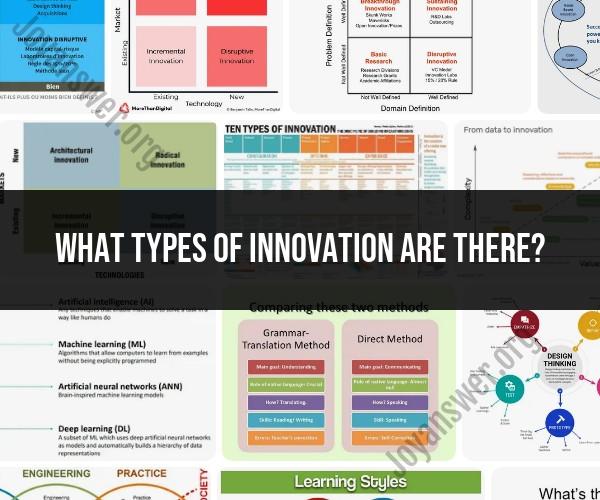What types of innovation are there?
Innovation comes in various forms, and it can be categorized into several types, each with its own characteristics and impact on markets and industries. Here are some common types of innovation:
Incremental Innovation: Incremental innovation involves making small, gradual improvements to existing products, processes, or services. It often focuses on refining existing features or optimizing efficiency. This type of innovation is common in mature industries and is essential for maintaining competitiveness.
Sustaining Innovation: Sustaining innovation is a type of incremental innovation that aims to enhance an organization's existing products or services to meet evolving customer needs or market demands. It helps companies maintain their market positions and customer loyalty.
Disruptive Innovation: Disruptive innovation is a transformative type of innovation that introduces entirely new products, services, or business models that disrupt and replace existing ones. It often starts in niche markets and gradually gains mainstream adoption, potentially leading to the displacement of established players.
Radical Innovation: Radical innovation is a significant departure from existing products, services, or processes. It can result in entirely new industries or the creation of groundbreaking technologies. Radical innovations often require significant resources and carry higher risks but can yield substantial rewards.
Open Innovation: Open innovation involves collaborating with external partners, such as customers, suppliers, research institutions, or startups, to access new ideas, technologies, and expertise. It recognizes that valuable innovations can come from sources beyond an organization's boundaries.
Platform Innovation: Platform innovation focuses on creating a core technology or infrastructure that enables the development of a range of complementary products, services, or applications. Platforms can attract a vibrant ecosystem of developers and partners, leading to rapid growth.
Process Innovation: Process innovation entails improving or reimagining internal processes and operations to enhance efficiency, reduce costs, or streamline workflows. It can lead to increased productivity and competitiveness.
Business Model Innovation: Business model innovation involves rethinking how an organization creates, delivers, and captures value. It can involve changes in revenue streams, pricing strategies, distribution channels, or customer engagement approaches.
Service Innovation: Service innovation focuses on enhancing or creating new service offerings, often driven by changes in customer preferences or emerging technologies. It can lead to improved customer experiences and differentiation in service-based industries.
Product Innovation: Product innovation involves developing new or improved products, features, or functionalities to meet changing customer demands or market trends. It can encompass physical products, software, or digital goods.
Social Innovation: Social innovation addresses societal challenges by developing solutions that create positive social or environmental impact. It often involves partnerships between government, nonprofits, and businesses to address complex issues.
Design Innovation: Design innovation emphasizes the user experience, aesthetics, and usability of products, services, or environments. It can enhance brand identity and customer engagement.
Technological Innovation: Technological innovation focuses on developing new technologies or leveraging existing ones to create innovative products or solutions. It often drives advancements in various industries.
These types of innovation are not mutually exclusive, and innovation efforts may involve a combination of several types to achieve desired outcomes. Successful innovation strategies often require organizations to balance incremental improvements with more disruptive or transformative initiatives, depending on their specific goals and competitive landscapes.
Exploring the Spectrum of Innovation: Types and Categories Defined
Innovation is the process of creating something new and valuable. It can be a product, service, process, or business model. Innovation can be incremental or radical, and it can be disruptive or sustaining.
Here is a brief overview of the different types and categories of innovation:
- Incremental innovation: Incremental innovation is the process of making small, gradual improvements to existing products, services, processes, or business models. This type of innovation is often the result of continuous improvement efforts.
- Radical innovation: Radical innovation is the process of creating something new and completely different from what exists today. This type of innovation often results in the creation of new markets or the disruption of existing markets.
- Disruptive innovation: Disruptive innovation is the process of introducing a new product, service, process, or business model that disrupts an existing market. Disruptive innovations often start out as low-end products or services that appeal to underserved or niche markets. Over time, disruptive innovations can become mainstream and displace existing market leaders.
- Sustaining innovation: Sustaining innovation is the process of improving existing products, services, processes, or business models to meet the changing needs of customers. This type of innovation is essential for businesses to maintain their competitive advantage.
Innovating for Success: Understanding the Different Forms of Innovation
There are many different forms of innovation. Some of the most common forms of innovation include:
- Product innovation: Product innovation is the process of creating new products or improving existing products. This can include developing new features, improving the performance of a product, or reducing the cost of a product.
- Process innovation: Process innovation is the process of developing new or improved processes for producing goods or services. This can include developing new manufacturing processes, improving the efficiency of existing processes, or reducing the environmental impact of processes.
- Service innovation: Service innovation is the process of creating new services or improving existing services. This can include developing new service offerings, improving the quality of service, or reducing the cost of service.
- Business model innovation: Business model innovation is the process of developing new or improved ways of doing business. This can include developing new revenue models, new customer acquisition strategies, or new ways to deliver value to customers.
Innovation Landscape: Navigating the Varied Terrain of Progress
The innovation landscape is constantly evolving. New technologies, new business models, and new ways of thinking are emerging all the time. To stay ahead of the curve, businesses need to be innovative and constantly looking for new ways to improve.
Here are a few tips for navigating the varied terrain of innovation:
- Be open to new ideas. Don't be afraid to try new things and experiment with new ideas. The best innovations often come from unexpected places.
- Be willing to fail. Failure is a natural part of the innovation process. Don't be discouraged if you don't succeed right away. Learn from your mistakes and keep trying.
- Be persistent. Innovation takes time and effort. Don't give up on your ideas easily. Keep working on them until you find a way to make them work.
Innovation is essential for businesses of all sizes and in all industries. By understanding the different types and categories of innovation, and by being innovative in your own business, you can stay ahead of the competition and achieve success.













